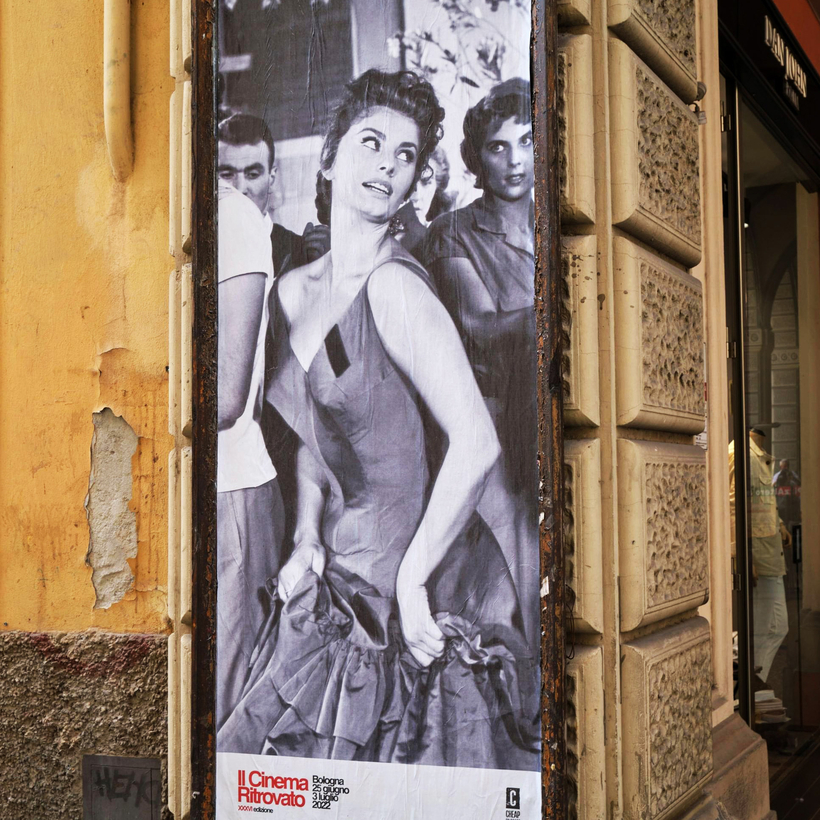Every June, tens of thousands of hardcore film fans from around the world make a pilgrimage to Italy. Their destination is Il Cinema Ritrovato, a festival in Bologna dedicated to the history of movies. Interest in the festival has exploded in recent years, so much so that organizers now use a digital-ticketing system that has put an end to the long queues that wrapped around Bologna’s streets.
As Hollywood executives continue to churn out bad films that lose money—box-office receipts are still well below pre-pandemic levels—Il Cinema Ritrovato has proved that certain audiences will not just pay to see good movies but travel thousands of miles for the privilege.
The festival draws filmgoers from France, the U.K., and Spain, but also from the United Arab Emirates, Chile, India, and beyond. While many visitors are veteran film specialists, Ritrovato is filled with young people. A young German bureaucrat from Bonn, Timo, told me he takes his vacation to Ritrovato every year. Students from the University of Bologna get discounted tickets and regularly pack screenings.

“Bologna has been invaded,” said Ritrovato’s founder, Gian Luca Farinelli, who is also the longtime director of the Cineteca di Bologna, on the second-to-last day of this year’s festival. Farinelli was speaking to a crowd of thousands gathered for an outdoor screening of Sergei Eisenstein’s 1925 feature debut, Strike, about a doomed workers’ revolt. What the festival has achieved, Farinelli added, is nothing short of “a miracle.”
When it began, in 1986, Ritrovato was a much sleepier affair: a forum for film archivists to develop the best practices for preserving, restoring, and exhibiting silent cinema. The festival grew organically, gradually expanding its program into sound films and cinema from around the world. “There was a moment where it started to become something that was talked about by those who make films,” Cecilia Cenciarelli, a festival co-director, tells me. Martin Scorsese, Isabella Rossellini, and Jim Jarmusch began showing up.
In spite of the attention, Ritrovato has maintained a spirit of democracy. “It’s probably one of the few festivals in the world that’s both very popular and niche,” Ehsan Khoshbakht, another co-director, says. “Everybody is equal in it. You don’t have different types of badges. Everybody goes in the same queue. Even I book my own tickets. At the same time, we show things that no one else would show.”

Today the festival presents about 500 films each year, which are divided into themed series—or “strands”—and catalogued with extensive notes and essays in an annual print monograph. “There is no other purely archival festival that shows as much as they do here,” says Peter Bagrov, head curator of moving images at the George Eastman Museum in Rochester. “It’s huge.”
The festival does more to shape the tastes of film programmers and cinephiles than any other institution. “As someone who works in the restoration world, this is where everybody is,” says Robert Byrne, head of the San Francisco Film Preserve, a nonprofit dedicated to restoring neglected films. “There is a certain buzz here.”
Ritrovato has earned its reputation for giving films the best presentation possible. Silents are screened with live musical accompaniment. This year, the festival occupied eight of Bologna’s cinemas, including the city’s crown jewel, the newly restored Multicinema Modernissimo, an underground movie palace built in 1915 beneath Via Rizzoli. Aboveground is the festival’s main attraction, an expansive outdoor theater set up in Piazza Maggiore whose free nightly screenings are open to the public and can attract as many as 7,000 people.
Ritrovato’s 2025 program brought together some recurring series such as “Cinemalibero,” a strand focused on non-Western films made between 1960 and 1980. As always, there were new restorations of popular classics like One Flew over the Cuckoo’s Nest and Brazil, plus cult obscurities including a restoration of Café Flesh, a 1982 science fiction skin flick described jokingly by programmer Daniel Bird as “the Citizen Kane of porn.”
I was drawn to the series on Lewis Milestone, a director who, at his peak in the 1930s was considered to be one of Hollywood’s great talents; the Hollywood trades saw in him a director on par with John Ford and Ernst Lubitsch. But this reputation never quite held. Milestone’s leftist activism landed him on the blacklist in the late 1940s. His career didn’t recover until 1960, when he was rescued by the Rat Pack and made Ocean’s Eleven. Critics dismissed even his most celebrated works—like Hallelujah, I’m a Bum and All Quiet on the Western Front—as movies “disassociated from any viewpoint,” as Andrew Sarris put it in The American Cinema.
Ritrovato’s series on Milestone, programmed by Khoshbakht, aimed to give the director’s career a second look. “His work was a persuasive, if sometimes wayward, attempt at unifying the world against suffering,” Khoshbakht writes in the notes accompanying the series. Nowhere was this attempt more visible than in Milestone’s 1939 adaptation of John Steinbeck’s Of Mice and Men, starring Burgess Meredith and Lon Chaney Jr. as George and Lennie, the down-on-their-luck laborers who delude themselves with visions of success.

Watching the festival’s 35-mm., sepia-toned print of the film, I was struck by how frequently the film’s exact scenario came up in other films I saw at the festival: Charlie Chaplin and Mack Swain as prospectors in 1925’s The Gold Rush; Doris Dowling and Silvana Mangano as farm workers in Giuseppe De Santis’s neo-realist classic Bitter Rice, from 1949; and even Jerry Lewis and Dean Martin as starving artists in a new restoration of Frank Tashlin’s 1955 masterpiece, Artists and Models.
“Different strands of the festival interact with each other,” Khoshbakht agrees. “They complement each other. They also question each other.” His point resonated with me early in the festival. A new 70-mm. print of Close Encounters of the Third Kind, Steven Spielberg’s nebulous portrait of extraterrestrial obsession and unfulfilled desire, screened in Piazza Maggiore, showed off one of Hollywood’s finest products from the late 70s.
Penelope Spheeris’s 1981 documentary, The Decline of Western Civilization, which follows seven Los Angeles punk bands, including Black Flag and X, as they play music, punch, and spit on their fans, cook bacon, and crush beers in their low-rent apartments, is a foundational document of American punk—the antithesis of Spielberg’s refinement. Spheeris examines a hostile cultural movement that scared people in a way aliens could not.
“There’s so much to watch here. You talk to people at the end of the festival about what they saw,” David Pierce, who oversaw moving-image preservation at the Library of Congress, now retired, tells me on the final day. “It’s like you each attended a different festival.”
One of Pierce’s favorite movies at Ritrovato was a restoration of a Swiss film from 1934 called Rapt, which screened to a packed audience at Modernissimo, and set the festival abuzz. Unlike most film festivals, there would be no lucrative bidding war for the rights to distribute Rapt abroad. Museums, collecting institutions, and some independent theaters might book the film for a limited engagement at some point in the future. Maybe it will get picked up by the Criterion Collection. It can take years for Ritrovato’s work to show up in other parts of the world, in cinema studies, local repertory theaters, or in the minds of filmmakers.
Such a timeline doesn’t bother Cenciarelli. “We think of ourselves as farmers,” she says. “We are spreading the seeds of things that we think are important and should be shared with others. The more the festival is successful, the more curious people will be to dig, write, and teach more histories of cinema.”
Will Tavlin is a New York–based writer. His work has appeared in Bookforum, the Columbia Journalism Review, and n+1

